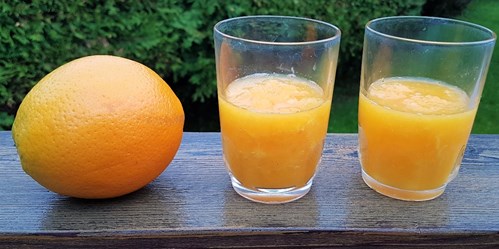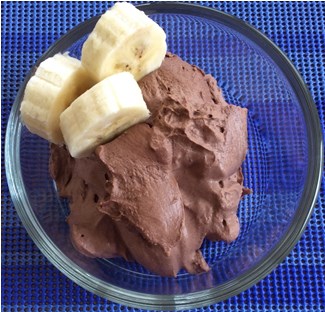Blog Categories
Recent Posts
- Home
- Real Food Matters
Real Food Matters
Posted by on

You know what this is?
That’s right, orange juice I just squeezed a minute ago.
It’s super fresh and chock-full of flavor and vitamins!
Our post today is about real food, and this awesome orange juice epitomizes everything I want to tell you about it, which I can basically summarize in three lines:
1. Real food is made from
real, natural, simple ingredients.
2. Real food is nutritious and supports our health, and is therefore far superior to
processed foods which are not great for us.
3. Making
real food from scratch is totally doable.
Now let’s put our orange juice to the test.
Point #1? - Check. Our orange juice is made from an orange. Nothing else.
Point #2? - Check. Our juice was still a fruit a scant minute ago, all its vitamins alive and kicking! No factory juice will ever be as fresh as that.
Point #3? - Check. Squeezing an orange is a cinch.
Yes, our homemade orange juice passed the test!
Let’s look at some more examples of real, natural, simple ingredients (point #1).
Mostly, these are foods you can intuitively recognize as coming from nature, with no or minimal processing: fresh and frozen fruits and veggies, whole plain dairy products (not skimmed and without added sugar), eggs, nuts, sourdough breads, organic grass-fed beef, free-range chicken, bone broths made from organic grass-fed beef or free-range chicken, wild fish, natural fats, fermented veggies.
On the other side of the scale are processed foods, which are not great for us. Before we move on, let’s understand why.
Examples of processed foods are: breakfast cereals, store-bought sweetened yogurts, candy, soda pops, instant meals in a cup or in a pouch, ready-made canned meals, most factory-made frozen microwavable meals, food in fast food chains.
It’s so pervasive, most of us consume a lot of this type of foods. (My apologies to you, dear reader, if you’re one of the few who still cook from scratch).
With the exception of small-scale artisanal producers using natural minimal processing to make healthy wholesome foods, ‘processed foods’ are food products made in mass-production factories, where the food undergoes various synthetic alterations.
Processed food products may be modified, fortified, reduced, enriched, skimmed, homogenized, irradiated, hydrogenated or hydrolyzed (whatever that means).
Often other substances are added, in order to make the final product more profitable: preservatives will make its shelf-life longer, additives, synthetic vitamins, fake aromas, and artificial colors will make it seem fresher than it actually is, and refined sugar and artificial flavors will enhance its taste, ensuring customers keep coming back for more.
The result is a heavily-processed, often poor-quality, lifeless product, rather than a living food.
I wonder how many of the original nutrients, if any, survive these aggressive interventions and make it all the way to our plates.
If you read the lists of ingredients on your groceries, you’ll notice that some of them are unrecognizable. I don’t know about you, but I like knowing what’s in my food. If I can’t understand what it is, I don’t want it in my cart.
Studies show that the human body doesn’t deal very well with this type of foods. It doesn’t know how to digest these unnatural compounds, and often mistakes them for foreign invaders, which wreak havoc on our health in the long run.
Since no factory or fast food chain will ever care about our health as much as we do, we’ve decided in our family to take matters into our hands and make our own food whenever possible.
Where do we find the time and budget for cooking from scratch? In one word – priorities.
We allocate more time for cooking at the expense of watching TV, and we buy high-quality real ingredients, while drastically cutting down on eating out and on unhealthy stuff. We won’t be buying any new electronic gadgets any time soon, either.
Back to our culinary quest for fun real food.

Let’s make fruit-flavored yogurt! And by that I mean the real thing, like the one you see in the picture, not the sweetened yogurt you get in the store, which –despite the healthy image- nowadays is closer to ice cream than to fresh yogurt. 10
Super easy to make. Just cut up a few fresh fruits into a bowl of whole plain yogurt (not skimmed), and savor the exquisite flavor of fresh yogurt!
Want it sweeter? Adding a mashed banana into the yogurt or some raw honey, should do it.
Humans have been making their own food up until not very long ago and all throughout history.
Cooking was not considered drudgery, but something to be proud of. An essential life skill, and a very satisfying one at that!
Let’s draw some inspiration from our ancestors’ traditional foods. For example, what did they have for breakfast?
Well, I can tell you what they DIDN’T have: breakfast cereals. At least not in the modern sense of the word.
Actually, breakfast was often savory. Eggs, a chunk of home-baked dark bread with butter and perhaps some bacon. If a sweeter breakfast was desired, oats and other grains would be slowly simmered in whole milk with nuts and dried fruits, resulting in a rich porridge.
Modern breakfast cereals –which probably originate from this historical granola porridge 10– are heavily processed and high in sugar, akin to a dessert, and offer us mostly empty calories.
And what if our ancestors craved candy?
Sorry folks. Candy is a modern invention and for most of history simply didn’t exist, therefore no one craved it. And lucky them, in those days diabetes and obesity were almost unheard of.
What did they do when they wanted chicken soup? They had to make it themselves of course. They would simmer chicken, carrots, celery and herbs for several hours. I can almost smell the aroma of the brewing soup filling the house… Hang on. I actually DO smell the aroma of chicken soup filling the house! Oh! Right! That’s because there’s chicken soup simmering in the kitchen while I’m writing this paragraph…
(If I tickled your interest, here’s my family’s traditional chicken soup recipe.)
Cooking from scratch is not necessarily costly or time consuming. No need for special cooking skills either. Remember our orange juice? One orange, one minute, half a dollar. There. No excuses. No one is too busy, too broke, too tired, or too unskilled to squeeze an orange.
Food matters. It’s our fuel. It has a direct effect on our health and well-being. Let’s not take our body for granted. Let’s not force poor quality food on it, but give it the best fuel possible.
Real food is nutritious, flavorful and alive. It doesn’t need all those fake substances we mentioned earlier, to make it attractive. It’s attractive to start with!
Try and see for yourself how great you feel when you eat this way.
Which reminds me. We went on vacation for the holidays during which we mostly ate out or ordered in, or stopped on the high way for a quick fast food meal. After a few days of eating like that, I just craved my own kitchen, my own cooking, my own homemade chocolate-banana pudding… yeah…

Let’s make it!
Real, whole, simple ingredients, coming together in two minutes, for a dessert worth every drool!
You blend till smooth all the following: one very ripe banana, 2/3 cup organic whipping cream, a spoonful cocoa powder, and a couple drops pure vanilla extract. Serves one.
Now you’re armed with a solid proof that real food is fun to make!
Eating real nutritious food will support our body, and we won’t need to repair it with medicine so much and so often. Many modern diseases are diet-related. Doesn’t it make sense we should eat better in order to stay healthier? How does spending very little on food now but a lot on health care later (often as a result of poor food choices) even make sense?
Go now to your kitchen and look at the counter, in the pantry, in the fridge, and in the freezer. A moment of truth. These are your food choices right there. Are they good for you? Do they support you? Do they feel right?
Our post today was about mindful eating.
Enjoy real food, and if possible make it yourself!
Wishing you a wonderful weekend filled with whole yogurts and squeezed oranges!
Didi
Wise Choice Market
References and inspirations for this post:
1. EE 101: Teaching Slow Food Values in a Fast Food World - Alice Waters and Craig McNamara (YouTube)
2. Edible education 101: what’s next for the food movement, with Michael Pollan and Mark Bittman (YouTube)
3. Cooked, by Michael Pollan
4. Food Inc. (YouTube)
5. The Truth About Your Food with FOOD, INC. Filmmaker Robert Kenner (YouTube)
6. Traditionally Fermented Foods, by Shannon Stonger.
7. Alice Waters - Edible Education: Teaching the Art of Simple Food; Family Action Network (YouTube)
8. A Life Unburdened, by Richard Morris
9. Wasted! The Story of Food Waste, with Chef Anthony Bourdain (YouTube)
10. What's wrong with what we eat | Mark Bittman (YouTube)
11. Michael Pollan: Fixing Food (YouTube)
12. Folks, This Ain't Normal: A Farmer's Advice for Happier Hens, Healthier People, by Joel Salatin
Disclaimer:
This article represents its author’s opinion, and is not a medical, nutritional, or professional advice.


 Loading... Please wait...
Loading... Please wait...













